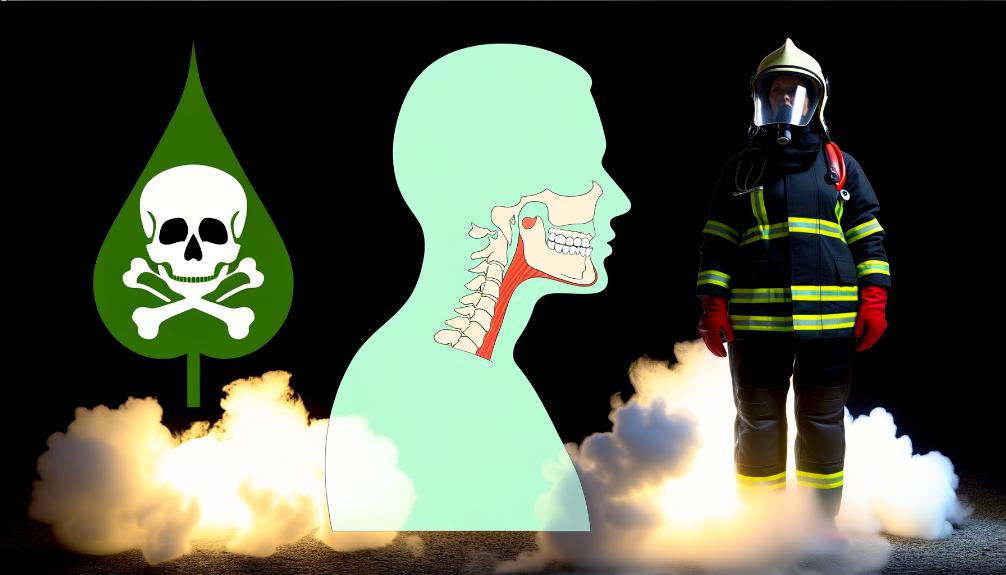Thyroid Disease and AFFF Exposure: Proving Causation
We've explored the link between AFFF exposure and thyroid disease, focusing on the importance of proving causation. AFFF, containing PFAS chemicals, is recognized for its significance in the environment and potential to bioaccumulate, leading to health concerns including thyroid dysfunction. Recent studies underline the correlation between PFAS exposure and thyroid disease, emphasizing the need for thorough research to understand this connection better. In legal frameworks, establishing causation is vital for compensation claims, requiring detailed documentation and expert testimony. We highlight the significance of timely legal advice and proper evidence collection. Moving forward, deeper insights await those pursuing the nuances of this intricate relationship.

Key Takeaways
- Recent studies link AFFF exposure to significant thyroid disease risks, demonstrating a causative relationship.
- PFAS compounds in AFFF disrupt thyroid hormone production, underpinning thyroid dysfunction.
- Legal processes require medical documentation linking AFFF exposure to thyroid conditions.
- Meta-analysis research provides evidence of PFAS's impact on thyroid health, crucial for proving causation.
- Specialist legal assistance is essential for navigating compensation claims for thyroid disease due to AFFF exposure.
Understanding AFFF

Aqueous Film-Forming Foam, or AFFF, was first developed in 1966 and has since been an essential tool in firefighting, especially within military contexts. Its unique ability to suppress fuel fires rapidly by covering the fuel surface with a film has made it indispensable at training areas, hangars, and aircraft crash sites. However, the presence of per- and polyfluoroalkyl substances (PFAS) in AFFF raises significant health concerns, particularly concerning thyroid diseases among military firefighters.
We've come to understand that PFAS, the chemicals that give AFFF its fire-suppressing properties, are not without their drawbacks. These substances are persistent in the environment and have been linked to a range of health issues, including thyroid diseases. This connection is especially concerning for military firefighters, who, due to their professional duties, may have elevated exposure levels to AFFF. The health concerns associated with PFAS exposure from AFFF usage highlight the need for ongoing research and alternative firefighting methods that do not compromise the health of those tasked with protecting us.
The issue at hand is not just about the effectiveness of AFFF in firefighting but also about the long-term health implications for those exposed to its PFAS contents. As we dig deeper into the impact of these substances, it becomes clear that the balance between firefighting efficiency and the health of military personnel must be carefully managed. Our collective goal should be to safeguard the safety and well-being of our firefighters without adding to their health burdens.
PFAS Chemical Properties
We're turning our attention to the chemical properties of PFAS, which are notable for their chemical stability and potential health impacts. These synthetic compounds, integral in firefighting foams, exhibit a resistance to environmental degradation and a propensity for bioaccumulation. It's essential we explore how these properties might influence health outcomes, particularly concerning thyroid function.
PFAS Chemical Stability
Given their strong carbon-fluorine bonds, PFAS compounds are remarkably stable, resisting degradation in various environments and posing risks of long-term exposure. This chemical stability means they don't break down easily, leading to persistent environmental concerns. As these substances bioaccumulate in organisms and biomagnify up the food chain, the potential for significant health impacts increases, underlining the urgency to address their presence. Their surfactant properties, attributed to the unique chemical structure of long carbon chains and fluorine atoms, contribute to their widespread use despite these concerns. It's essential we comprehend the resilience of PFAS compounds against degradation to fully grasp their long-lasting effects on ecosystems and human health, emphasizing the need for stringent regulations and effective cleanup methods.
Health Impact Overview
Understanding the chemical properties of PFAS is essential, as they're linked to significant health risks, including thyroid disease and endocrine disruption. PFAS chemicals, such as PFOA and PFOS, are notorious for their persistence in the environment and their ability to accumulate in living organisms. These synthetic compounds, used in products like AFFF firefighting foams, possess surfactant properties due to their long carbon chains bonded to fluorine atoms. This structure not only makes them incredibly stable and resistant to degradation but also contributes to their bioaccumulation potential. The association between PFAS exposure and adverse health impacts, particularly thyroid dysfunction and endocrine disruption, highlights the critical need for awareness and action. The accumulation of PFAS in human tissues, including the thyroid gland, underscores the serious risk of thyroid-related health impacts from exposure.
Thyroid Function Basics

How does the thyroid gland work to regulate our body's metabolism and overall health? To understand this, it's important to explore the fundamentals of thyroid function. The thyroid gland, situated at the base of our neck, plays a pivotal role in our body's ability to manage energy, growth, and metabolism. This regulation is achieved through the synthesis and release of hormones, primarily through the intricate hypothalamic-pituitary-thyroid axis. This axis guarantees the appropriate levels of thyroid hormones, such as T3 (triiodothyronine) and T4 (thyroxine), are maintained.
These hormones are vital for a variety of physiological functions, including but not limited to maintaining body temperature, controlling the heart rate, and ensuring proper brain development. A disruption in the production or regulation of T3 and T4 can lead to significant health issues. For instance, an underactive thyroid, known as hypothyroidism, can result in fatigue, weight gain, and depression. On the other hand, an overactive thyroid, or hyperthyroidism, can cause weight loss, anxiety, and heart palpitations.
Understanding thyroid function is not just about comprehending how our body regulates its metabolism and growth. It's also about recognizing the potential impact environmental factors, such as exposure to AFFF (Aqueous Film Forming Foam), can have on our thyroid health. Before diving into how AFFF exposure disrupts thyroid function, it's crucial to grasp these thyroid function basics to appreciate the full extent of potential health implications.
AFFF and Thyroid Disruption
While we've established the importance of thyroid function in regulating our body's metabolism and health, it's equally vital to recognize how exposure to AFFF can disrupt this delicate balance. AFFF, or aqueous film-forming foam, is widely used in firefighting but contains PFAS compounds like PFOA and PFOS, which are notorious for their ability to interfere with hormone regulation and act as endocrine disruptors. This, in turn, can lead to significant thyroid disruption.
PFAS compounds have the ability to accumulate in thyroid cells, where they can exert cytotoxic effects and disrupt the normal functioning of the thyroid. This disruption can manifest in various thyroid disorders, including hypothyroidism and Hashimoto's thyroiditis. These conditions are characterized by an imbalance in hormone production, which is essential for maintaining our body's metabolism, energy levels, and overall health.
What's particularly alarming is the heightened risk among firefighters regularly exposed to AFFF. Due to the endocrine-disrupting properties of PFAS, these individuals are more susceptible to developing thyroid disorders. The accumulation of PFAS in thyroid cells can impact thyroid hormone synthesis, leading to abnormal levels of thyroid hormones. This not only affects the thyroid's ability to function properly but can also pave the way for potential thyroid diseases.
Understanding the link between AFFF exposure and thyroid dysfunction is essential. It underscores the need for awareness and protective measures to mitigate the risk of thyroid disorders stemming from exposure to these hazardous chemicals.
Research and Studies Overview

As we delve into the relationship between AFFF exposure and thyroid disease, it is crucial to examine the key research findings that illuminate this connection. We will also assess the methodologies employed in these studies to grasp the robustness of the causation evidence presented. This overview aims to offer a thorough understanding of how PFAS exposure potentially affects thyroid health.
Key Research Findings
Recent studies have revealed a significant link between AFFF exposure and thyroid disease, highlighting the impact of specific PFAS compounds on thyroid hormone levels in adults. Our analysis of these findings underscores the intricate association between thyroid function and exposure to substances like PFOS, PFOA, and PFHxS. PFOS demonstrates a notable correlation, being positively associated with free T4 and TSH levels, yet showing an inverse relationship with total T4. Conversely, PFOA's influence appears more restrained, exhibiting a modest correlation with total T3 but lacking significant ties to other thyroid hormones. Meanwhile, PFHxS is distinctively negatively correlated with total T4, without significant associations with free T4, total T3, or TSH. This complex web of correlations elucidates the nuanced impact of PFAS on thyroid health.
Study Methodologies Evaluated
Understanding the link between AFFF exposure and thyroid disease necessitates a closer look at the methodologies behind the research. Our analysis focused on a meta-analysis that adhered to PRISMA guidelines, meticulously evaluating 449 articles for their relevance to PFAS exposure and thyroid function. Researchers meticulously assessed methodological quality, with articles scoring between six to eight on quality items, ensuring a high standard of evidence. They employed pooled z values, calculated through Pearson correlation coefficient and transformed by Fisher z-transformation, to rigorously analyze the correlations. Subgroup and sensitivity analyses were conducted to explore the heterogeneity of results. These methodological approaches revealed a negative association between specific PFAS compounds and total T4 levels, suggesting a potential for thyroid hormone disruption due to PFAS exposure.
Causation Evidence Strength
We've gathered robust evidence from research studies that firmly establish the link between PFAS exposure and thyroid dysfunction. Meta-analysis research highlights this connection, particularly the thyroid hormone disruption in adults, pointing towards a high risk of thyroid issues. Specific PFAS compounds, including PFOS, PFOA, and PFHxS, have shown varied correlations with thyroid hormone levels, underpinning the thyroid-disrupting potential of these chemicals. This evidence suggests that PFAS exposure can induce thyroid dysfunction and disease, emphasizing the need for awareness and preventive measures. Moreover, the negative association between certain PFASs and total T4 levels underscores the potential health risks, reinforcing our understanding of the causative relationship between AFFF exposure and thyroid disease. Thorough research and analysis are pivotal in unraveling this complex association.
Legal Framework and Compensation

Traversing the legal landscape for compensation due to thyroid disease from AFFF exposure often requires specialized legal guidance. The legal process can be intricate, involving the meticulous gathering of medical records, employment, and military service documentation to establish a clear link between AFFF exposure and thyroid disorders. For those affected, including firefighters and military personnel, understanding the steps to secure compensation is vital.
We've learned that obtaining thorough documentation of medical records and symptoms is the first pivotal step in the compensation claims process. This documentation serves as the foundation for proving causation, a task that's far from simple but essential in the fight for justice and compensation.
Legal assistance, particularly from attorneys specializing in cases related to AFFF exposure, becomes indispensable. These legal experts are well-versed in maneuvering the intricacies of such cases, ensuring that all necessary evidence is compiled and presented effectively. Their knowledge extends to reviewing employment and military records, critical steps for military personnel seeking justice for their suffering.
Promptly seeking legal advice and beginning the evidence-gathering process are essential steps for anyone looking to pursue compensation for thyroid issues caused by AFFF exposure. The journey might seem challenging, but with the right legal assistance, individuals can navigate the legal process more smoothly and improve their chances of securing the compensation they deserve.
Diagnosis and Treatment Challenges
We've observed that accurately diagnosing thyroid disease in those exposed to AFFF presents unique challenges, including high misdiagnosis rates and the misidentification of related conditions. The variability in treatment options, alongside the critical need for ongoing monitoring and adjustments, further complicates the care for affected individuals. It's imperative that we advocate for multiple expert consultations to guarantee the correct approach is taken from diagnosis through to treatment.
Identifying Thyroid Symptoms
Identifying symptoms of thyroid disease can be challenging, as they often mimic those of other conditions like depression or general fatigue. The challenges in diagnosis stem from this symptom overlap, which can obscure the clear picture of a thyroid disorder. Despite these hurdles, recognizing thyroid symptoms is crucial for pursuing an accurate diagnosis. This often requires hormone replacement therapy or other medication for effective treatment. Given the complexity, it's advisable to seek multiple medical opinions. This approach guarantees not only an accurate diagnosis but also the appropriate management of the condition. The journey to a correct diagnosis is essential for the prognosis of those affected, highlighting the importance of understanding the nuanced nature of thyroid symptoms and their overlap with other conditions.
Treatment Options Variability
Exploring the treatment landscape for thyroid disease isn't simple, as options vary greatly depending on the specific diagnosis. The journey begins with managing diagnosis challenges, where thyroid disease symptoms often overlap with other conditions, resulting in misdiagnosis rates between 40-60%. This variability necessitates thorough medical evaluations, possibly requiring multiple opinions to achieve an accurate diagnosis. Given this complexity, treatment options can range from medication and radioactive iodine therapy to surgery, contingent on the precise condition identified. These challenges highlight the critical need for specialized medical care and legal assistance. Ensuring an accurate diagnosis paves the way for appropriate treatment, underscoring the importance of expertise in both medical and legal fields in managing thyroid conditions, especially those related to AFFF exposure.
Monitoring and Adjustments
Managing the complexities of diagnosing and treating thyroid disease in those exposed to AFFF requires constant vigilance and adaptability in our approach. Misdiagnosis is common due to symptoms that overlap with other conditions, such as heart disease, sleep disorders, and vitamin deficiencies. This necessitates thorough evaluations by multiple specialists to differentiate thyroid disease from other misdiagnosed conditions. The challenges we face stem from the need to take into account symptoms that may mimic other health issues, potentially delaying treatment. Additionally, treatment adjustments for those exposed to AFFF may be complex, requiring personalized approaches that take into consideration each individual's health history, exposure levels, and symptom severity. Monitoring involves regular follow-ups and detailed assessments to track thyroid function changes, optimize treatment, and address any emerging complications.
Military Firefighters Risk
We must acknowledge that military firefighters are at a significant risk due to their exposure to Aqueous Film-Forming Foam (AFFF). Since its inception in 1966, AFFF has been a staple in military firefighting efforts, utilized in training areas, airport hangars, and during aircraft crash responses. Despite the planned phase-out by 2025, the persistent use of AFFF at military bases and among civilian firefighters continues to pose a threat to those exposed to its harmful effects.
The root of the concern lies in the per- and polyfluoroalkyl substances (PFAS) found in AFFF. These chemicals, known for their persistence in the environment and in the human body, have been linked to various health risks, including thyroid disease. For military firefighters, exposure is not limited to the use of AFFF itself but is also prevalent through the personal protective equipment they wear, increasing their risk of developing health issues.
Given the potential for severe health outcomes, it's important for military and civilian firefighters alike to understand the implications of AFFF exposure. Establishing causation between AFFF exposure and the onset of thyroid disease is a complex process, yet it's an important step for those seeking compensation for their suffering. Legal assistance can play a significant role in maneuvering this challenging landscape, offering a pathway to compensation for those affected.
As we continue to uncover the full extent of health risks associated with AFFF exposure, it's essential that we support our military firefighters in this battle, not just against fires but against the invisible threat to their health.
Impact on Pregnancy and Fetal Development

Beyond the risks to military firefighters themselves, it's important to contemplate how PFAS exposure during pregnancy can greatly impact both maternal and fetal health. Maternal PFAS exposure, we've learned, is not without significant consequences. It has been closely linked to adverse pregnancy outcomes, including preterm birth and low birth weight. These outcomes don't just affect the immediate health of the newborn but can have long-lasting effects on maternal and child health.
The mechanism of harm seems rooted in thyroid hormone disruption. PFAS can cross the placental barrier, a fact that underscores the potential impact on pregnancy. This crossing not only exposes the fetus to these chemicals but can also influence fetal thyroid development. The thyroid plays a vital role in the development and function of many bodily systems. Any disruption in fetal thyroid development due to maternal PFAS exposure can lead to developmental issues that may not become apparent until after birth.
Understanding the impact of PFAS on pregnancy and fetal development is essential. Thyroid hormone disruption in pregnant women due to PFAS exposure raises significant concerns. It's not just about the health of the expectant mother but also about the future health and development of the child.
Seeking Legal Assistance
For those impacted by thyroid disease due to AFFF exposure, seeking legal assistance is often an important step in securing compensation. We grasp the complexities involved in proving the link between AFFF exposure and thyroid disease, and it's evident that specialized legal guidance is vital for firefighters aiming to file claims. These professionals meticulously review employment and medical records to determine eligibility, making sure that every piece of evidence contributes to building a strong case.
Documenting symptoms meticulously and obtaining all relevant military or employment records are pivotal steps in this process. This documentation forms the foundation of the legal strategy, as it helps establish the causation between AFFF exposure and the onset of thyroid disorders. Given the intricate nature of such cases, having skilled legal professionals by our side can greatly ease the burden. They navigate the maze of legal requirements with expertise, guiding us through each step with precision.
It's essential to act promptly and make sure all documentation is accurate and thorough. Delays or inaccuracies can impede our chances of receiving the compensation we deserve. The role of legal assistance in these scenarios cannot be overstated. Their expertise not only aids in proving causation but also ensures that we, as firefighters and individuals exposed to AFFF, are adequately compensated for our suffering.
Preventive Measures

While seeking legal assistance is an important step for those affected by AFFF exposure, it's equally important to focus on preventive measures to avoid future health risks. Implementing preventive measures against AFFF exposure is essential to safeguarding public health and the environment. One effective strategy is the use of alternative firefighting foams that do not contain PFAS compounds. These alternatives can substantially reduce the risk of harmful exposure.
Moreover, regular monitoring of water sources, especially on military bases where AFFF has been extensively used, plays a key role in identifying and mitigating PFAS contamination risks. This proactive approach ensures that any potential threats to water quality are addressed promptly, safeguarding communities from exposure.
The implementation of stricter guidelines and regulations governing the use of AFFF containing harmful PFAS chemicals is another crucial preventive measure. By imposing limitations on the use and distribution of these substances, we can minimize environmental and health risks associated with their exposure.
Furthermore, training programs designed for firefighters on the safe handling and disposal of AFFF can help minimize exposure risks. Educating those on the front lines about the dangers of PFAS and proper protective measures can greatly reduce the likelihood of harmful exposure.
Symptoms and Early Detection
As we explore the topic of thyroid disease and its link to AFFF exposure, it's critical we're aware of how to recognize its early signs. Understanding the common symptoms and the significance of prompt testing cannot be overstated, as early detection plays a pivotal role in effective management and treatment. By keeping an eye out for these indicators, we can take proactive steps towards safeguarding our health.
Identifying Common Symptoms
We'll start by identifying the common symptoms of thyroid disease in individuals exposed to AFFF, focusing on early detection for better outcomes. Symptoms to watch for include unexplained weight changes, sleep disturbances, muscle weakness, temperature sensitivity, anxiety, and vision problems. Specifically, veterans may notice hair loss, memory problems, and infertility, hinting at thyroid dysfunction. Understanding symptoms such as tremors, menstrual irregularities, and fatigue is important. Additionally, an enlarged thyroid gland, irritability, and a hoarse voice should raise concerns. Recognizing these signs early can be important in proving causation between AFFF exposure and thyroid disease, ensuring those affected receive timely and appropriate care. Early detection plays a pivotal role in managing the health impacts of AFFF exposure on thyroid function.
Importance of Early Testing
Understanding the significance of early testing for thyroid disease, particularly in those exposed to AFFF, is essential for managing and mitigating its varied symptoms effectively. Symptoms such as weight fluctuations, sleep issues, and muscle weakness can often be dismissed as less serious conditions, making it important to recognize these early signs of thyroid dysfunction. Sensitivity to temperature changes, anxiety, and tremors further emphasize the need for quick action. Additionally, fatigue, hair loss, and memory lapses are indicators that shouldn't be ignored. For individuals with AFFF exposure, timely testing is necessary for identifying potential health impacts, ensuring the possibility of prompt and appropriate medical care. Early detection paves the way for timely treatment, influencing the management and outcome of thyroid disease.
Case Studies and Testimonies

Case studies and personal testimonies from firefighters have illuminated the stark connection between AFFF exposure and the onset of thyroid diseases. Through meticulous examination of these case studies, we've observed elevated rates of thyroid disorders such as hypothyroidism and Hashimoto's disease among those with a history of AFFF exposure. Firefighters, who've courageously shared their stories, highlight the correlation, drawing a clear line between their work environments and their subsequent health issues.
Medical records of these brave individuals reveal a worrying trend: a higher incidence of thyroid dysfunction following exposure to AFFF-containing products. This documentation is pivotal, as it not only supports the symptoms reported by the firefighters but also strengthens the causation argument in legal spheres. Symptoms consistent with thyroid disease in these firefighters provide a tangible link between AFFF exposure and thyroid dysfunction, reinforcing the need for accountability and safety measures.
Furthermore, legal claims filed by these firefighters are pushing the boundaries of how we comprehend and compensate occupational health risks. They're not merely seeking recompense; they're highlighting a significant public health issue. By attributing their thyroid conditions to AFFF, they emphasize the urgency of proving causation. This legal process is paramount, not only for the compensation of affected individuals but also in driving policy changes to protect firefighters from hazardous exposures in the future.
In essence, these case studies and testimonies are pivotal in our ongoing battle to grasp and mitigate the health risks associated with AFFF exposure. They're not just stories; they're evidence of a significant occupational hazard that demands our immediate attention.
Future Directions in Research
To effectively address the intricate issue of AFFF exposure and its connection to thyroid disease, it's essential for future research to delve further into both the causal relationships and underlying mechanisms. We're looking at the need for longitudinal studies with larger sample sizes to provide a more in-depth understanding. These studies will allow us to track the progression of thyroid disease over time in individuals exposed to AFFF, offering critical insights into how and when these diseases develop.
Long-term monitoring of thyroid function in populations known to have been exposed to AFFF is another pivotal piece of the puzzle. It's through this monitoring that we can gather valuable data on disease progression, which is key to establishing a direct link between exposure and illness.
Delving into the molecular mechanisms by which PFAS in AFFF affect thyroid function is also essential. Understanding these mechanisms at a molecular level will help us establish causation, moving us closer to definitive answers and potential interventions.
Furthermore, collaborative efforts between researchers, healthcare professionals, and regulatory bodies are crucial. It's only through working together that we can address the gaps in our understanding of the link between AFFF exposure and thyroid disorders. These partnerships are essential for developing effective strategies for disease prevention and management.
Lastly, future studies should not overlook the potential synergistic effects of AFFF exposure with other environmental factors. Exploring how these interactions might contribute to the development of thyroid disease will provide a more nuanced understanding of the risks and pave the way for more targeted regulatory measures.

This post has been generated by AI and was not reviewed by editors. This is Not legal advice. Please consult with an attorney.




